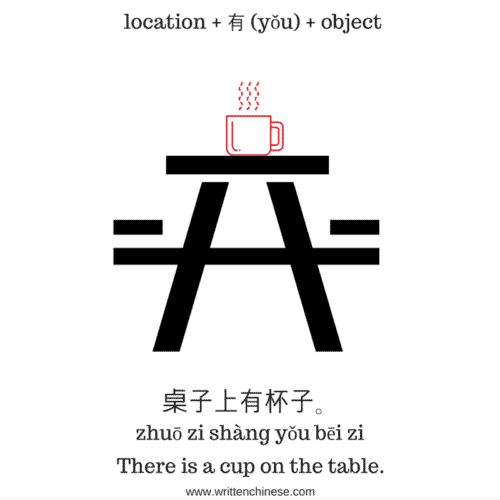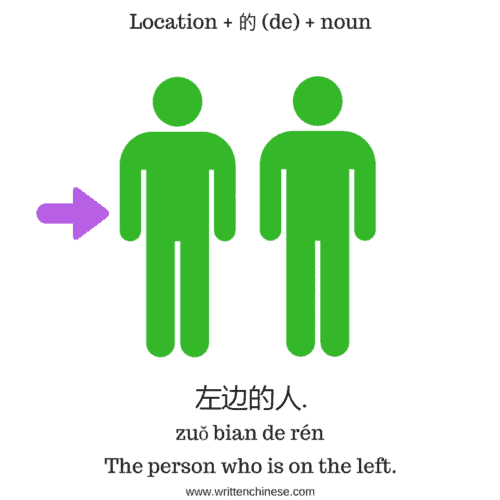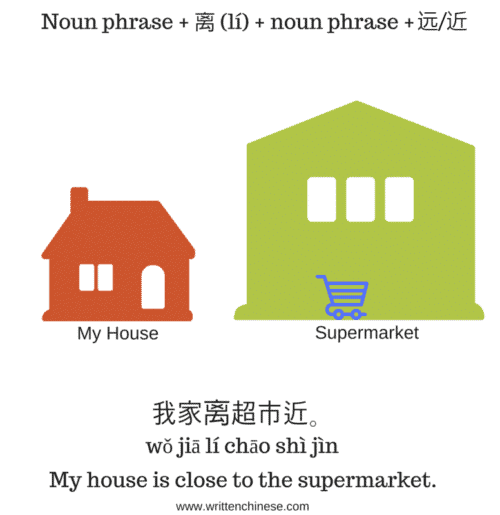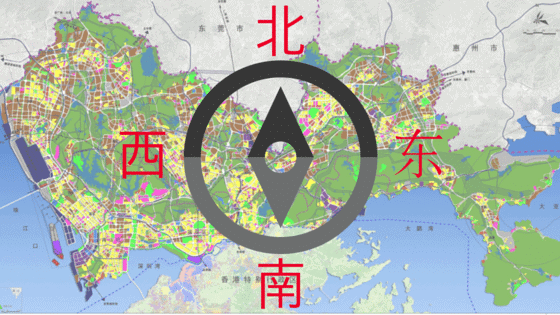In this article, we’re going to look at two related topics: location and directions in Chinese. First, I’m going to introduce some basic location words and then some sentence patterns that you can use to describe where objects are, if an object exists and locations as description. The second part of the article will focus more on phrases and vocabulary that will be useful when asking for and giving directions in Chinese.
Location in Chinese
方位词 (fāng wèi cí) or location nouns are used to express both direction and location. These can be divided into two sections, 单纯方位词 (dān chún fāng wèi cí) simple localizers and 合成方位词 (hé chéng fāng wèi cí) compound localizers.
The following characters are 单纯方位词 (dān chún fāng wèi cí) Simple localizers: 上 (shàng), 下 (xià), 前 (qián), 后 (hòu), 左 (zuǒ), 右 (yòu), 里 (lǐ), 外 (wài), 东 (dōng), 南 (nán), 西 (xī), 北 (běi).
If a character such as 之 (zhī) and 以 (yǐ) is added before the simple localizer or 面 (miàn), 边 (bian), 头 (tou), 方 (fāng) and 部 (bù) after the simple localizer and this will create a compound localizer, such as the following: or example: 以上 (yǐ shàng), 之前 (zhī qián), 里面 (lǐ miàn), 外边 (wài bian), 后头 (hòu tou), 前方 (qián fāng), 西部 (xī bù), 左右 (zuǒ yòu) and 内外 (nèi wài).
Generally, the 单纯方位词 (dān chún fāng wèi cí) simple localizer can not be used alone, except when part of a commonly used phrase such as 上有老下有小 (shàng yǒu lǎo xià yǒu xiǎo), meaning ‘to support both your elderly parents and your children’ and 前怕狼 后怕虎 (qián pà láng hòu pà hǔ), which means ‘to be overcautious’.
合成方位词 (hé chéng fāng wèi cí) compound localizers can be used alone. For example:
外面很热。(wài mian hěn rè) It is hot outside.
西边的学校。(xī biān de xué xiào) The school in the west.
Localizers are always used after other words to make a 方位词组 (fāng wèi cí zǔ) Localizer phrase. These are used to express a location or time.
For example:
书在桌子上。(shū zài zhuō zi shàng) The book is on top of the table.
两年以前我们就认识了。(liǎng nián yǐ qián wǒ men jiù rèn shi le) We knew each other two years ago.
Although the simplest use of a localizer is to express the location, sometimes 上 (shàng) , 中 (zhōng) and 下 (xià) do not express a physical location:
For example:
在学习上,他一直很努力。(zài xué xí shàng, tā yī zhí hěn nǔ lì) He always works hard when he studies.
在她的帮助下,我顺利完成了学业。(zài tā de bāng zhù xià, wǒ shùn lì wán chéng le xué yè) With her help, I completed my studies successfully.
他们招飞行员,要求身高在一米七以上。(tā men zhāo fēi xíng yuán, yāo qiú shēn gāo zài yī mǐ qī yǐ shàng.) They recruited pilots, whose height can be no less than 1.70m.
| location | 面 miàn | face/side | 边 biān | side | ||||
|---|---|---|---|---|---|---|---|---|
| 上 | shàng | on | 上面 shàng mian | on top of | 上边 shàng bian | on top/above | ||
| 下 | xià | under | 下面 xià mian | below/ under | 下边 xià bian | below/ under | ||
| 里 | lǐ | in | 里面 lǐ miàn | inside | 里边 lǐ bian | inside | ||
| 外 | wài | out | 外面 wài mian | outside | 外边 wài bian | outside/outer surface | ||
| 前 | qián | front | 前面 qián miàn | ahead/ infront | 前边 qián bian | front/the front side | ||
| 后 | hòu | back | 后面 hòu mian | back/ behind | 后边 hòu bian | back/ behind | ||
| 左 | zuǒ | left | 左面 zuǒ miàn | left side | 左边 zuǒ bian | the left side of | ||
| 右 | yòu | right | 右面 yòu miàn | right side | 右边 yòu bian | the right side of | ||
| 对 | duì | toward | 对面 duì miàn | opposite | ||||
| 旁 | páng | next to | 旁边 páng biān | beside | ||||
| 中 | zhōng | middle | 中间 zhōng jiān | between | ||||
| 南 | nán | south | 南面 nán miàn | south side | 南边 nán bian | south side | ||
| 北 | běi | north | 北面 běi miàn | north side | 北边 běi biān | north side | ||
| 东 | dōng | east | 东面 dōng miàn | east side | 东边 dōng bian | east side | ||
| 西 | xī | west | 西面 xī miàn | west side | 西边 xī biān | west side |
在 zài
The character 在 (zài) can be used in several different ways, but in this instance it is being used as ‘is located at/in’.
For example
在英国。(zài yīng guó) [is located] In the United Kingdom…
Describing the Location of an Object

If you wish to say that an object is in a particular place, use the following sentence pattern:
Object + 在 (zài) + place + (的 (de)) + location
裙子在衣柜(的)里面。(qún zi zài yī guì (de) lǐ miàn) The dress is in the wardrobe.
The 的 (de) particle is used here to mean ‘of the’, so the sentence basically reads
‘the dress is located in the wardrobe’s inside’. You can read about the 的 (de) particle in more detail in the article, How to use the ‘de’ particles 的, 得 and 地 in Chinese.
Indicating an object exists or not

In Chinese, the character 有 (yǒu) is more often used to say ‘have’ or combined with 没 (méi) to produce 没有 (méi yǒu), meaning ‘not to have’. To indicate that something exists in a place, we use the 有 (yǒu) character. Essentially we are saying that a place ‘has’ an object.
location + 有 (yǒu) + object
桌子上有杯子。(zhuō zi shàng yǒu bēi zi) There is a cup on the table.
location + 没有 (méi yǒu) + object
房子里没有人。(fáng zi lǐ méi yǒu rén) There is no one inside the house.
Describing with Location

When using a location to describe something, you need to use the following pattern:
Location + 的 (de) + noun
左边的人。(zuǒ bian de rén) The person who is on the left.
后面的车。(hòu mian de chē) The car that is behind.
Distances – Near and Far

The words to use for ‘near’ or ‘far’ are as follows:
远 (yuǎn) – far
近 (jìn) – near
You can also add an adverb, such as 很 (hěn), to say ‘very’ far 很远 (hěn yuǎn).
When talking about distances, we frequently use the character 离 (lí), which means ‘away from’. The sentence will be something like, ‘this place + away from + this place +[is] far/near’.
Noun phrase + 离 (lí) + noun phrase + 远 (yuǎn) /近 (jìn)
我家离超市近。(wǒ jiā lí chāo shì jìn) My house is close to the supermarket.
公园离学校很远。(gōng yuán lí xué xiào hěn yuǎn) The park is very far from the school.
Specific Distances
When you need to tell someone that a place is specific distance from somewhere, we add 有 (yǒu) + distance. Remember, 有 (yǒu) means ‘to have’, so the sentence becomes ‘a place + away from + a place + has this much distance between them’.
Noun phrase + 离 (lí) + noun phrase + 有 (yǒu) + distance
我公司离酒吧有五里。(wǒ gōng sī lí jiǔ bā yǒu wǔ lǐ) My company is 5 miles from the bar.
Here are some useful measurements of distance:
英里 (yīng lǐ) a mile
公里 (gōng lǐ) a kilometer
公尺 (gōng chǐ) Metre
里 (lǐ) Chinese mile
Asking if a place is near or far
Noun phrase + 离 (lí) noun phrase 远不远 (yuǎn bù yuǎn)?
Noun phrase + 离 (lí) noun phrase 近不近 (jìn bù jìn)?
你家离图书馆远不远?(nǐ jiā lí tú shū guǎn yuǎn bù yuǎn?) Is your home far (or not far) away from the library?
OR
Noun phrase + 离 (lí) noun phrase 远吗 (yuǎn ma)?
Noun phrase + 离 (lí) noun phrase 近吗 (jìn ma)?
你家离图书馆近吗? (nǐ jiā lí tú shū guǎn jìn ma?) Is your home close to the library?
Directions in Chinese
Asking Where a Place is
Place + 在 (zài) + 哪儿 (nǎr ) /哪里 (nǎ lǐ)?
超市在哪儿?(chāo shì zài nǎr) /超市在哪里?(chāo shì zài nǎ lǐ)
Where is the supermarket?
超市在图书馆的旁边。(chāo shì zài tú shū guǎn 的 páng biān) The supermarket is next to the library.
Asking How to Get to a Place
A simple way to ask someone how to get somewhere is by asking:
怎么走?(zěn me zǒu?)
How do I get there?
However, if you need to be more specific and ask how to get from one place to another use the following pattern:
从 (cóng) + place + 到 (dào) + place 怎么走?(zěn me zǒu?)
从酒店到商场怎么走?(cóng jiǔ diàn dào shāng chǎng zěn me zǒu.)
How do I get from the hotel to the mall?
从。。。到 means ‘from….to’.
Taking and Giving Directions in Chinese
Here are some simple instructions for giving and taking directions:
The character 往 (wǎng) means ‘to go in the direction of’ and the final character, 拐 (guǎi) means ‘turn’. The following sentence pattern is to say ‘make a right/left turn’.
往 (wǎng) + direction + 拐 (guǎi)。
往左拐。(wǎng zuǒ guǎi) Turn left.
To tell someone to go straight forward, you don’t need to use 往 (wǎng), just use the phrase,
一直走。(yī zhí zǒu) Go straight ahead.
We’ll look at transportation and getting around in more detail in a future article.
Exercises

Translate the English sentences into Chinese.

1: The polar bear is sitting is the left side of the rabbit.

2: The rabbit stood in the front of the fox.

Translate the Chinese into English.
3: 北京在中国的北部,广州在中国的南部。
The answers are in the comment section of The China Story of a Laowai Lifer.
